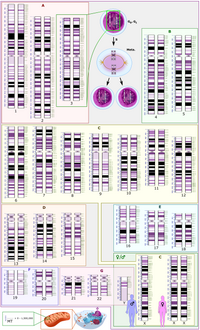
Photo from wikipedia
The objective of this study was to evaluate the addition of active dry Saccharomyces cerevisiae (yeast) to the diet of steers during the late finishing phase on performance, rumen pH… Click to show full abstract
The objective of this study was to evaluate the addition of active dry Saccharomyces cerevisiae (yeast) to the diet of steers during the late finishing phase on performance, rumen pH and mRNA expression of genes relating to barrier function and immune response. 54 steers were blocked by weight and randomly assigned to one of two treatments: control (CON; n = 27) or yeast (fed at 60B CFU/hd/d; VistaCell, AB Vista, YST; n = 24). The corn-based finisher (60% high moisture corn, 20% dried distillers grains, and 17% alfalfa haylage, DM basis) ration was fed for 55± 15.9 days until slaughter. Every 28 days, weight and ultrasound of back and rump fat depths were recorded. Three to five days before slaughter, blood was collected via jugular venipuncture for measures of circulating metabolites, serum amyloid-A, and haptoglobin. Reticulo-rumen pH was recorded using an in-dwelling probe for 4 weeks leading up to slaughter. Rumen papillae were obtained for histological measurements, and to assess mRNA expression of genes related to gut barrier function (OCLN, CLDN, ZO1, ZO2) and immune response (TLR2, TLR4, FCAR). Data were analyzed as a complete randomized block design using PROC GLIMMIX in SAS, with treatment as a fixed effect, and block as a random effect. Feeding yeast in the late finisher diet decreased dry matter intake (11.97 and 8.24 ± 0.507 kg/day for CON and YST, respectively; P < 0.001) while maintaining average daily gains (P = 0.50), therefore improving feed conversion (P < 0.001) for YST steers. No differences were found between CON and YST steers for blood metabolites, including immune response markers (P ≥ 0.13), rumen mRNA expression (P ≥ 0.07), and rumen pH (P ≥ 0.08). Yeast addition to the late finishing diet significantly improved feed conversion through the decrease in dry matter intake without impacts on carcass quality or animal performance.
Journal Title: Journal of Animal Science
Year Published: 2019
Link to full text (if available)
Share on Social Media: Sign Up to like & get
recommendations!